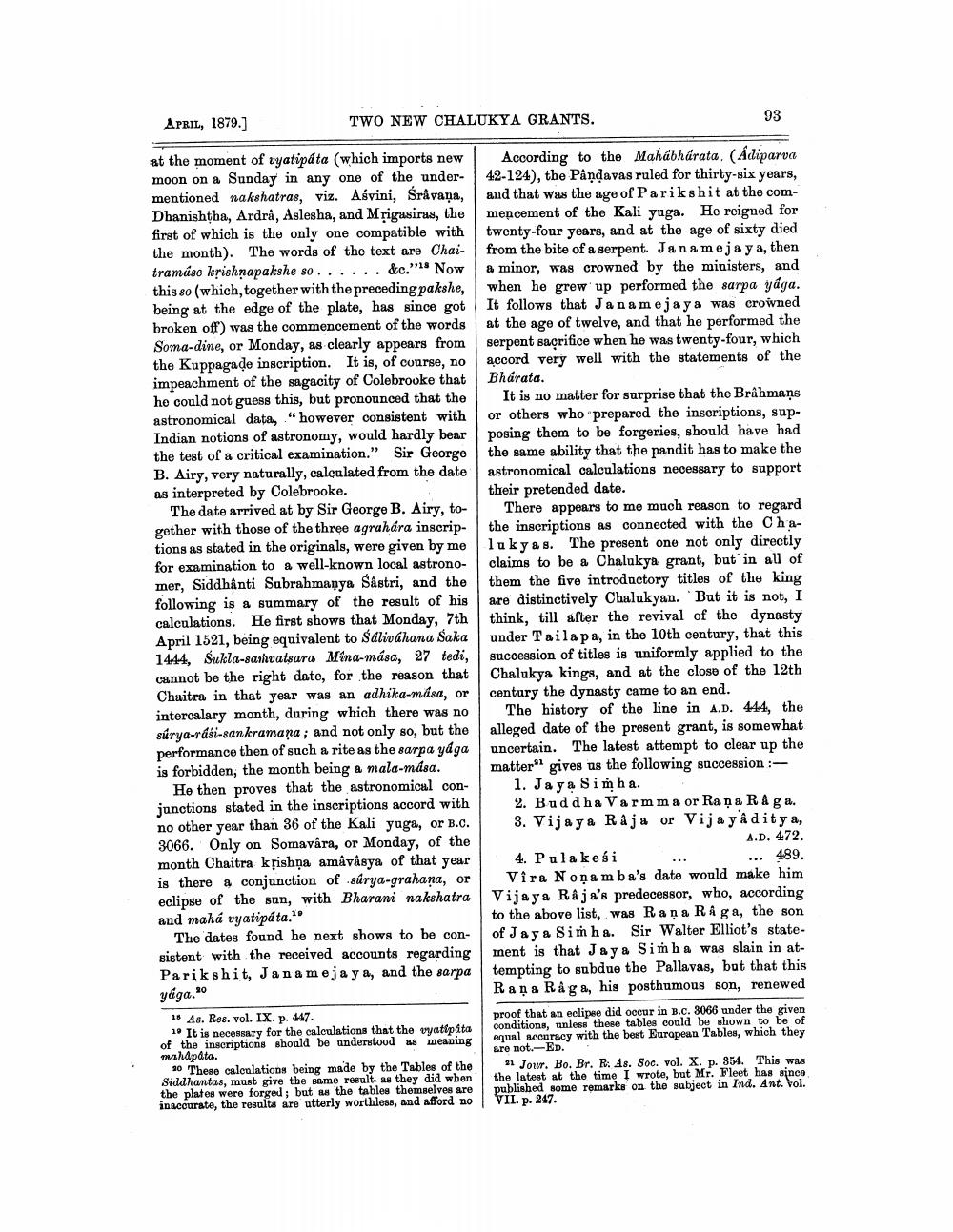________________
TWO NEW CHALUKYA GRANTS.
APRIL, 1879.]
18
at the moment of vyatipáta (which imports new moon on a Sunday in any one of the undermentioned nakshatras, viz. Aśvini, Śrâvana, Dhanishtha, Ardrâ, Aslesha, and Mrigasiras, the first of which is the only one compatible with the month). The words of the text are Chaitramáse krishnapakshe so. . . . . . &c." Now this so (which, together with the preceding pakshe, being at the edge of the plate, has since got broken off) was the commencement of the words Soma-dine, or Monday, as clearly appears from the Kuppagade inscription. It is, of course, no impeachment of the sagacity of Colebrooke that he could not guess this, but pronounced that the astronomical data, "however consistent with Indian notions of astronomy, would hardly bear the test of a critical examination." Sir George B. Airy, very naturally, calculated from the date as interpreted by Colebrooke.
The date arrived at by Sir George B. Airy, together with those of the three agrahára inscriptions as stated in the originals, were given by me for examination to a well-known local astronomer, Siddhânti Subrahmanya Sâstri, and the following is a summary of the result of his calculations. He first shows that Monday, 7th April 1521, being equivalent to Salivahana Saka 1444, Sukla-samvatsara Mina-mása, 27 tedi, cannot be the right date, for the reason that Chaitra in that year was an adhika-mása, or intercalary month, during which there was no surya-rasi-sankramana; and not only so, but the performance then of such a rite as the sarpa yaga is forbidden, the month being a mala-mása.
It is no matter for surprise that the Brahmans or others who prepared the inscriptions, supposing them to be forgeries, should have had the same ability that the pandit has to make the astronomical calculations necessary to support their pretended date.
He then proves that the astronomical conjunctions stated in the inscriptions accord with no other year than 36 of the Kali yuga, or B.C. 3066. Only on Somavara, or Monday, of the month Chaitra krishna amâvâsya of that year is there a conjunction of surya-grahana, or eclipse of the sun, with Bharani nakshatra and mahá vyatipata.10
The dates found he next shows to be consistent with the received accounts regarding Parikshit, Janamejaya, and the sarpa yaga,"
18 As. Res. vol. IX. p. 447.
19 It is necessary for the calculations that the vyatipata of the inscriptions should be understood as meaning mahapata.
93
20 These calculations being made by the Tables of the Siddhantas, must give the same result. as they did when the plates were forged; but as the tables themselves are inaccurate, the results are utterly worthless, and afford no
According to the Mahabharata. (Adiparva 42-124), the Pândavas ruled for thirty-six years, and that was the age of Parikshit at the commencement of the Kali yuga. He reigned for twenty-four years, and at the age of sixty died from the bite of a serpent. Jana meja y a, then a minor, was crowned by the ministers, and when he grew up performed the sarpa yaga. It follows that Janamejaya was crowned at the age of twelve, and that he performed the serpent sacrifice when he was twenty-four, which accord very well with the statements of the Bharata.
There appears to me much reason to regard the inscriptions as connected with the Chalukyas. The present one not only directly claims to be a Chalukya grant, but in all of them the five introductory titles of the king are distinctively Chalukyan. But it is not, I think, till after the revival of the dynasty under Tailapa, in the 10th century, that this succession of titles is uniformly applied to the Chalukya kings, and at the close of the 12th century the dynasty came to an end.
The history of the line in A.D. 444, the alleged date of the present grant, is somewhat uncertain. The latest attempt to clear up the matter" gives us the following succession:
1. Jaya Simha.
2. Buddha Varmma or Rana Råga. 3. Vijaya Raja or VijayAditya, A.D. 472. 489. 4. Pulakesi Vira Nonamba's date would make him Vijaya Raja's predecessor, who, according to the above list, was Rana Riga, the son of Jaya Simha. Sir Walter Elliot's stateinent is that Jaya Simha was slain in attempting to subdue the Pallavas, but that this Rana Raga, his posthumous son, renewed
proof that an eclipse did occur in B.c. 3066 under the given conditions, unless these tables could be shown to be of equal accuracy with the best European Tables, which they are not.-ED.
21 Jour. Bo. Br. R. As. Soc. vol. X. p. 354. This was the latest at the time I wrote, but Mr. Fleet has since. published some remarks on the subject in Ind. Ant. vol. VII. p. 247.




